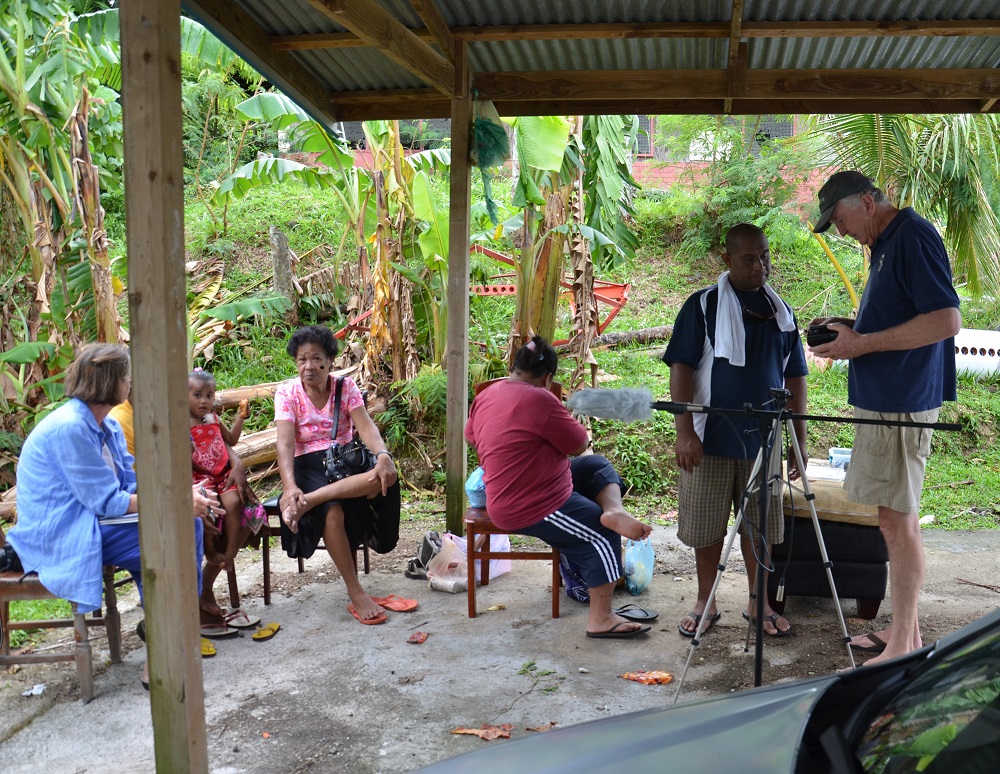Documenting Ramari Hatohobei, the Tobian language, a severely endangered Micronesian language

Landing page image for the collection “Documenting Ramari Hatohobei, the Tobian language, a severely endangered Micronesian language”. Click on image to access collection.
| Language | Tobian (Ramari Hatohobei) |
| Depositor | Peter Black, Barbara Black |
| Affiliation | Friends of Tobi Island |
| Location | Palau |
| Collection ID | 0295 |
| Grant ID | SG0242 |
| Funding Body | ELDP |
| Collection Status | Collection online |
| Landing Page Handle | http://hdl.handle.net/2196/64bb8850-a53d-42b4-b162-23091d844831 |
Showreel
Blog post
Summary of the collection
Tobian (Ramari Hatohobei) is the language of Tobi (Hatohobei), one of the Southwest Island states of the Republic of Palau, a Micronesian nation in the western Pacific. Severely endangered, Tobian is currently spoken by approximately 150 people. Tobian and its closely related languages of Sonsorol, Merir, and Pulo Anna, the other three Southwest Islands, are also related to the languages spoken in the outer islands of Yap and Chuuk. Intensive work was done with elderly Tobian speakers to document their language through collection of vocabulary, stories, poems, songs, meetings, and discussions in their relevant socio-cultural context.
Group represented
The community represented in this collection consists of the people of Hatohobei.
Tobian (Ramari Hatohobei) is the language of Tobi (Hatohobei), one of the Southwest Island states of the Republic of Palau, a Micronesian nation in the western Pacific. Severely endangered, Tobian is currently spoken by approximately 150 people. Tobian and its closely related languages of Sonsorol, Merir, and Pulo Anna, the other three Southwest Islands, are also related to the languages spoken in the outer islands of Yap and Chuuk. Intensive work was done with elderly Tobian speakers to document their language through collection of vocabulary, stories, poems, songs, meetings, and discussions in their relevant socio-cultural context.
Tobian is a small endangered language being redefined and subsumed daily as it coexists in a small community embedded within a larger society speaking an unrelated language that is dominant in everyday life. Members of the community speak or understand many other languages including English, Indonesian, Japanese, and, in the past, German. All of these languages have left traces in Tobian. Palauan and English are the national languages in the Republic of Palau; Tobian is only distantly related to Palauan.
Language information
Tobian is a nuclear Micronesian language belonging to the Oceanic subgroup of the Austronesian language family.
Collection contents
Notes on Navigating the Tobian Language Deposit
This collection consists of 88 bundles containing Tobian language material, including video stories, songs, prayers, a poem, Bible readings, conversations, community meetings, and histories. We also recorded discussions of fishing techniques, canoe building, basket making, taro gardening, medicines and sickness, and other topics.
We include a preliminary dictionary database of over 3000 words, many with audio clips of Tobian speakers pronouncing them, as well as illustrations, and references to more complete material. The audio clips, illustrations, and references are currently available only at
https://www.friendsoftobi.org/TobianLexicon/index-english/index.htm
Much of this material was collected in 2013-2014 by Peter W. Black and Barbara W. Black funded by the Endangered Languages Documentation Programme. The small grant awarded by ELDP supported a year’s work in 2013-2014. Three month-long research trips to Palau were separated by time processing and analyzing material collected in the field and preparing for the next trip.
We have added other videos, photographs, and sound recordings made over the last 55 years.
Bundles may contain video recording(s), audio recording(s), and/or photograph(s). Some bundles also contain transcription, translation, extended metadata, and/or descriptive text.
Other bundles may contain only one item, for example, a children’s story in Tobian and English.
Finding aids include two PDF documents, fully searchable:
• Overview of Deposit: a master list of bundles containing bundle number, date, name of contributor and topic, length, and if transcribed and/or translated. See
http://hdl.handle.net/2196/afeaf929-9287-4582-aab6-2a40cbf03152.
• Metadata for each bundle and its contents allowing the collection to be searched by: bundle number, date, type of file (for example, pdf, jpg, wav, mp4), name of contributor, topic, and associated bundles. See
http://hdl.handle.net/2196/24120650-3596-4f8b-8431-febbca245945.
Collection history
The goal of this project was to provide a resource base of well-documented Tobian language use. This resource base, intended for the use of the Tobian community now and in the future as well as for use by linguists, consists primarily of video records of people speaking Tobian in various contexts and covering various topics. This small grant awarded by ELDP supported a year’s work in 2013-2014. Three month-long research trips to Palau were separated by time processing and analyzing material collected in the field and preparing for the next trip.
Over the course of the project year, we worked with and recorded 31 Tobian speakers, more than 50 percent of the adult speakers of the language living in Palau.
Acknowledgement and citation
HOPE Hatohobei Organization for People and the Environment, a local NGO, served as our host organization and provided administrative and other support throughout the project year.
We wish to thank the people of Tobi who enthusiastically supported this project.
For further information about Tobi Island and its people and language, visit the Friends of Tobi Island website at http://www.friendsoftobi.org.
Users of any part of the collection should acknowledge Peter W. Black and Barbara W. Black as the data collectors and researchers. Users should also acknowledge the Endangered Languages Documentation Programme as the funder of the project. Individual speakers whose words and/or images are used should be acknowledged by name. All information on contributors is available in the metadata.
To refer to any data from the collection, please cite as follows:
Black, Peter W. & Barbara W. Black. 2022. Documenting Ramari Hatohobei, the Tobian language, a severely endangered Micronesian language. Endangered Languages Archive. Handle: http://hdl.handle.net/2196/00-0000-0000-0002-EB3B-F. Accessed on [insert date here].


